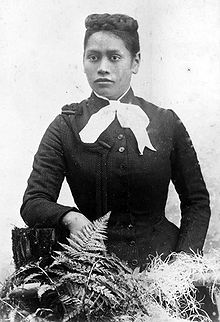| Meri Mangakāhia | |
|---|---|
 Meri Te Tai Mangakāhia in the 1890s Meri Te Tai Mangakāhia in the 1890s | |
| Born | Meri Te Tai (1868-05-22)22 May 1868 Lower Waihou, near Panguru, Northland, New Zealand |
| Died | 10 October 1920(1920-10-10) (aged 52) Panguru, Northland, New Zealand |
| Nationality | New Zealand |
| Occupation | Suffragist |
| Spouse | Hāmiora Mangakāhia |
Meri Te Tai Mangakāhia (22 May 1868 – 10 October 1920) was a campaigner for women's suffrage in New Zealand, who inspired future generations of Māori women.
Biography
Mangakāhia was born Meri Te Tai in Lower Waihou near Panguru in the Hokianga valley. A member of the Te Rarawa iwi, she was of Ngāti Te Rēinga, Ngāti Manawa and Te Kaitutae origin, and was the daughter of Re Te Tai, an influential chief. Mangakāhia was educated at St Mary's Convent in Auckland. She was an accomplished pianist. Mangakāhia was the third wife of Hāmiora Mangakāhia, an assessor in the Native Land Court, and in June 1892 he was elected Premier of the Kotahitanga Parliament in Hawke's Bay. The following year, she addressed the assembly (the first woman to do so), submitting a motion in favour of women being allowed to vote for, and stand as, members of the Parliament. She was asked to come to the House to speak to her motion, and in doing so, she became the first woman to speak to Te Kotahitanga. Mangakāhia's argument was that Māori women had always traditionally been landowners, but under Colonial law they were losing this land. She felt that Māori men weren't progressing to resolve land disputes with the Crown, and that Queen Victoria might respond better to requests from other women. She noted that Māori women were landowners, and should not be barred from political representation.
In 1893 she was involved in establishing Ngā Kōmiti Wāhine, committees associated with the Kotahitanga Parliament.
In 1897, Mangakāhia's dreams were realised when women won the right to vote in Te Kotahitanga elections.
She later joined the women's committee of the Kotahitanga movement, committees which were early forerunners of the Māori Women's Welfare League, and remaining involved in Māori politics and welfare movements. She started Te Reiri Karamu (The Ladies' Column) with Niniwa I te Rangi of Wairarapa. This collection of articles and letters was a place where Māori women raised and debated women's issues.
She died of influenza at Panguru on 10 October 1920 according to family members, and was buried at Pureirei cemetery, Lower Waihou, near her father. She had four children – two sons, Mohi and Waipapa, and two daughters, Whangapoua Tangiora Edith and Mabel Te Aowhaitini.
See also
References
- ^ Ballara, Angela. "Mangakahia, Meri Te Tai". Dictionary of New Zealand Biography. Ministry for Culture and Heritage. Retrieved 21 November 2015.
- Clarke, Chanel (14 November 2018). "Meri's parliamentary chest and Mary Ann's chair". Auckland War Memorial Museum – Tāmaki Paenga Hira. Retrieved 7 May 2019.
- Macdonald, Charlotte, ed. (1991). "Meri Mangakāhia". The book of New Zealand Women. Wellington: Bridget Williams Books. pp. 413–415. ISBN 0-908912-04-8.
- "Trailblazers: Meri Te Tai Mangakāhia". The New Zealand Herald. 13 September 2019. Retrieved 19 September 2018.
- Te Manatū Taonga, Ministry for Culture and Heritage. "Mangakahia, Meri Te Tai". Te Ara – The Encyclopedia of New Zealand. Retrieved 13 October 2018.
- Brook, Karen. "Meri Te Tai Mangakāhia". Our Wāhine | 125 Extraordinary New Zealand Women. Retrieved 13 October 2018.
External links
- "So that women may receive the vote", text of Meri Te Tai Mangakāhia's address to the Kotahitanga Parliament in 1893, website of the New Zealand Ministry of Culture and Heritage
- He Māngai Wāhine – The Women's Voices a New Zealand On Air documentary ( 5.15 – 15.05 minute mark)
- Meri Te Tai Mangakāhia’s parliamentary chest